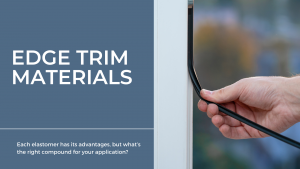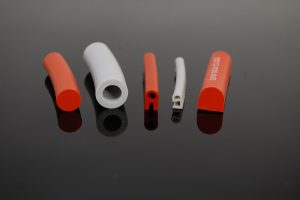PE film splicing and vulcanized hot splicing join cut lengths of rubber extrusions to create finished gaskets. PE film splicing uses heat, pressure, and a thin splice of polyetheyelene (PE) film. Vulcanized hot splicing uses heat, pressure, and rubber instead. Both methods use semi-automatic equipment and can support higher-volume production than cold bonding, a manual process.
PE film splicing and vulcanized hot splicing are both “hot bonding” techniques. Yet the similarities largely end there. By understand how each method works, engineers can make the right choice for finished gaskets. There are advantages to other gasket bonding methods, too, but are PE film splicing or vulcanized hot splicing right for your application?
PE Film Splicing
PE film splicing with infrared light features fast cycle times and produces strong corners that won’t crack Instead of heating a metal mold, an infrared splicer heats the entire surface of the rubber profile. This is especially important with taped profiles because cold tools won’t damage the tape. IR splicing won’t burn sponge rubber and won’t degrade PSA tapes or film liners either.
PE film splicing also supports larger, thicker gaskets such as the rubber gate seals used in water filtration systems. As this case study explains, Elasto Proxy used 60-durometer J-seals to solve a sealing challenge. With PE film splicing, it’s easy to hold down large, complex shapes. Because the clamps are wider, operators can make more splices at a time for greater production efficiencies.
According to NorMec, a leading manufacturer of PE joining equipment, an infrared splicer can produce as many as 225 profiles per hour by using tools with 3 cavities. Cycle times for EPDM profiles can take as little as 30 seconds. Although PE film splicing is a good choice for EPDM gaskets, it’s not recommended for silicone gaskets.
Vulcanized Hot Splicing
Vulcanized hot splicing can join cut lengths of many different types of rubber without retooling. Examples of these elastomers include EPDM, NBR, SBR, CR, and NR. Most PE film splices are 90°, but vulcanized hot splicing can support both straight cuts and angled cuts. Vulcanized hot splicing is also a good choice for extruded rubber profiles in small-to-medium sizes.
Vulcanized hot splicing takes longer than cold bonding but creates bonds that are both strong and long-lasting. That’s because vulcanization forms cross-links between sections of polymer chain. This curing process also improves the material’s mechanical properties to impart elasticity that supports the flexing of parts. Applications include door and window seals on mobile equipment.
Would you like to see an example of vulcanized hot splicing for yourself? Maybe you’d like to see PE film splicing instead. With Elasto Proxy’s new Super Gasket, you can see both bonding methods along with other gasket features. You can even compare these “hot bonding” techniques to cold bonding with and without a sealant. Request the Super Gasket today.
Gasket Splicing and Vendor Selection
Elasto Proxy is a rubber fabricator that can help you to choose the right bonding method for the custom gaskets that you need. For nearly 30 years, our solutions providers have worked with engineering and purchasing personnel in a variety of industries to solve sealing and insulation challenges. Whether you’ve worked with us before or are seeking a stronger supply chain in 2019, we hope you’ll contact us.
With the holidays fast-approaching, we’d also like to remind you of our year-end production schedule. Elasto Proxy will close at end-of-day on Friday, December 21, 2018 and re-open on Monday, January 7, 2018. For custom gaskets, please submit your orders by Friday, December 7, 2018. For standard products, please place your orders by Friday, December 14.











